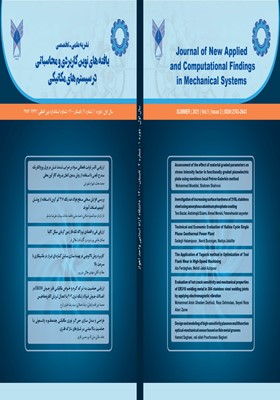بررسی افزایش سختی سطح فولاد ضد زنگ 316 کم کربن با استفاده از پوشش آلومینیم فسفات آمورف
محورهای موضوعی : یافته های نوین کاربردی و محاسباتی در سیستم های مکانیکیتارا بازدار 1 * , عبدالمجید اسلامی 2 , احمد منشی 3 , فاطمه سادات سیدان 4 , علیرضا عباسلو 5
1 - گروه خوردگی و حفاظت از مواد، دانشکده مهندسی مواد، دانشگاه صنعتی اصفهان، اصفهان، ایران
2 - مدیر گروه مهندسی خوردگی و حفاظت از مواد، دانشکده مهندسی مواد، دانشگاه صنعتی اصفهان، اصفهان، ایران
3 - گروه مهندسی مواد، دانشکده فنی مهندسی، دانشگاه آزاد اسلامی واحد اهواز، اهواز، ایران
گروه مهندسی مواد، دانشگاه صنعتی اصفهان، اصفهان،
4 - دانشکده مهندسی مواد، دانشگاه صنعتی اصفهان، اصفهان، ایران
5 - مدیر تحقیق و توسعه مجتمع مس شهربابک، شهربابک، ایران
کلید واژه: فولاد, آلومینیم فسفات آمورف, سختی, پوشش,
چکیده مقاله :
در این تحقیق روکش آلومینیم فسفات آمورف بر روی سطح فولاد ضد زنگ ۳۱۶ کم کربن برای افزایش سختی و مقاومت شیمیایی اعمال گردید. آمورف بودن به معنی نداشتن ساختار کریستالی و مرز دانه در نتیجه نداشتن ضعفهای مربوط به این دو پارامتر است. در این سنتز از محلولهای پیشساز آلومینیم نیترات نه آبه و پنتاکسیدفسفر در اتانول استفاده شد. 15 دقیقه تا دمای ۷۰ درجه سانتیگراد حرارت داده شد تا سل شفافی با ۷۵ درصد وزنی آلومینیم فسفات و نسبت مولی آلومینیم به فسفر ۷۵/۱ حاصل شود. بعد از اجرای عمل فعالسازی سطح صفحات فولادی و غوطه وری در سل آلومینیم فسفات در سه مرحله یک دقیقه ای به مدت ۲۴ ساعت در ۶۵ درجه سانتیگراد خشک و ۳۰ دقیقه در ۵۰۰ درجه سانتیگراد حرارت دهی شد. الگوی تفرق اشعه ایکس وجود هلال فاز آمورف را نشان دادکه با مقداری آلومینیم اضافی کنترل میشود. تصاویر میکروسکوب الکترونی روبشی و آنالیز طیف سنجی نشان داد که کنده شدن روکش در نمونه های فعال شده با ماربل بهتر از آکوارجیا و لوریا میباشد. آزمون میکروسختی بر روی نمونه عملیات حرارتی شده در ۵۰۰ درجه سانتیگراد حاکی از افزایش حدود سه برابری سختی در مقایسه با فلز زیر لایه بود.
In this study, amorphous aluminum phosphate coating was applied on 316L stainless steel surface to increase hardness and chemical resistance. Amorphous means no crystal structure and grain boundaries due to the lack of weaknesses related to these two parameters. In this synthesis, ethanol-based aluminum nitrate nonahydrate and phosphorus oxide precursor solutions were used. It was heated to 70 ° C for 15 minutes to obtain a clear sol with 75% by weight of aluminum phosphate and a molar ratio of aluminum to phosphorus of 1.75. After activating the surface of steel plates and immersion in aluminum phosphate sol, it was heated in three stages of one minute for 24 hours at 65 ° C and 30 minutes at 500 ° C. Continuous X-RAY diffraction pattern proved the existence of an amorphous structure and showed that it is controlled with some extra aluminum. Scanning electron microscopy images and spectroscopic analysis showed that the peeling of the coating in marble-activated samples was better than that of Aqua-Regia and Loria. The microhardness test on the heat-treated sample at 500 ° C showed a threefold increase in hardness compared to the substrate metal.
[1] Meetham G. (1986). Use of protective coatings in aero gas turbine engines. Materials science and technology 2(3). pp 290-294.
[2] Pomeroy M. (2005). Coatings for gas turbine materials and long term stability issues. Materials & design 26(3). pp 223-231.
[3] Shi F. (2012). Ceramic Coatings: Applications in Engineering. Intech Open, 249.
[4] Song R. (2003). Hydrogen permeation resistance of plasma-sprayed Al2O3 and Al2O3–13wt.% TiO2 ceramic coatings on austenitic stainless steel. Surface and Coatings Technology 168(2-3). pp 191-194.
[5] Salman S, Köse R, Urtekin L, Findik F. (2006). An investigation of different ceramic coating thermal properties. Materials & design 27(7). pp 585-590.
[6] Xu R, Pang W, Yu J, Huo Q, Chen J. (2008). Chemistry of zeolites and related porous materials: synthesis and structure, pp 253-255.
[7] sambasivan S, Steiner, KA. High Temperature Amorphous Composition Based on Aluminium Phosphate, 2004. US Patent No. 0011245
[8] Sambasivan S, Steiner, KA, Rangan, KK. Aluminum Phosphate Coatings, 2007. US Patent No. 7,311,944 B2
[9] sambasivan S , Steiner, KA, Rangan, KK. (2010). Aluminum Phosphate Coatings, Patent No. 0297000 A1
[10] Li N, Zhong M, Xu Z, Zhang Z. (2018). Polyesterification synthesis of amorphous aluminum phosphate thermal radiation material with high infrared emissivity. Materials Letters 213(pp 335-337.
[11] Liu M, Hu H, Zheng Y. (2017). Effects of three sealing methods of aluminum phosphate sealant on corrosion resistance of the Fe-based amorphous coating. Surface and Coatings Technology 309. pp 579-589.
[12] Wu F, Zhang X, Zhao, Taolin L, Li X, Man C. Renjie. (2015). Multifunctional AlPO4 coating for improving electrochemical properties of low-cost Li [Li0. 2Fe0. 1Ni0. 15Mn0. 55] O2 cathode materials for lithium-ion batteries. ACS applied materials & interfaces 7(6). pp 3773-3781.
[13] Walker L, Marotto V, Rafiee M, Koratkar N, Corral E. (2011). Toughening in graphene ceramic composites. ACS nano 5(4). pp 3182-3190.
[14] Sayyedan F, Enayati, M. (2019). On structure and oxidation behaviour of non-stoichiometric amorphous aluminium phosphate coating. Surface Engineering 35(8). pp 670-676.
[15] Bramfitt B, Benscoter A. (2001). Metallographer's guide: practice and procedures for irons and steels. Asm International. pp 360-367.
[16] Sayyedan FS, Enayati, MH. (2018). Evaluating oxidation behavior of amorphous aluminum phosphate coating. Applied Surface Science 455 .pp 821-830.
_||_
